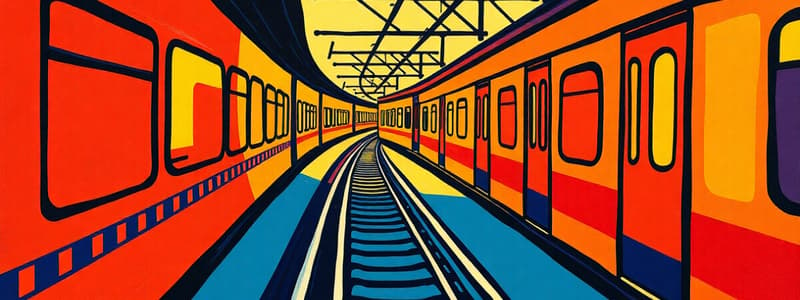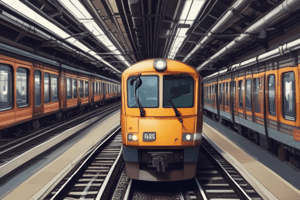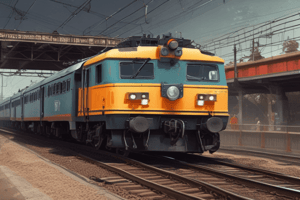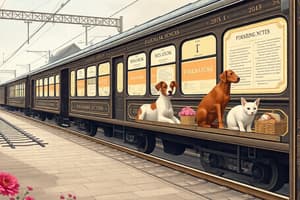Podcast
Questions and Answers
铁路运输具有高度集中的特点,各工作环节须紧密______、协同配合。
铁路运输具有高度集中的特点,各工作环节须紧密______、协同配合。
联系
国家铁路工作人员必须严格遵守和执行铁路______的规定,在自己的职责范围内,以对国家和人民负责的态度,保证安全生产。
国家铁路工作人员必须严格遵守和执行铁路______的规定,在自己的职责范围内,以对国家和人民负责的态度,保证安全生产。
规程
铁路局应根据历年降雨、洪水规律和当年的气候趋势预测,发布______命令,制定防洪预案。
铁路局应根据历年降雨、洪水规律和当年的气候趋势预测,发布______命令,制定防洪预案。
防洪
汛期前,须将______重点处所抄送相邻相关铁路局。
汛期前,须将______重点处所抄送相邻相关铁路局。
加强对电子电气设备的______防护及电磁兼容防护工作,逐步建立雷电预警系统。
加强对电子电气设备的______防护及电磁兼容防护工作,逐步建立雷电预警系统。
对铁路技术设备进行防寒过冬检查、______, 并根据需要做好包扎管路等工作。
对铁路技术设备进行防寒过冬检查、______, 并根据需要做好包扎管路等工作。
铁路______监测设备是保障铁路运输安全的重要技术设备,应具备监测、记录、报警、存取功能。
铁路______监测设备是保障铁路运输安全的重要技术设备,应具备监测、记录、报警、存取功能。
为保证机车良好的技术状态,应有进行______和整备作业的机务段、机车检修段等机务维修机构。
为保证机车良好的技术状态,应有进行______和整备作业的机务段、机车检修段等机务维修机构。
机车整备根据需要应有股道管理自动化系统和______, 设置机车补充砂、水、润滑油、燃料及转向、检查、检测、清洗等设备。
机车整备根据需要应有股道管理自动化系统和______, 设置机车补充砂、水、润滑油、燃料及转向、检查、检测、清洗等设备。
机车按牵引动力方式分为______、内燃机车,传动方式主要有交流传动和直流传动。
机车按牵引动力方式分为______、内燃机车,传动方式主要有交流传动和直流传动。
机车应有识别的标记:路徽、配属局段简称、车型、车号、最高运行速度、制造厂名及日期。在机车主要部件上应有______, 在监督器上应有检验标记。
机车应有识别的标记:路徽、配属局段简称、车型、车号、最高运行速度、制造厂名及日期。在机车主要部件上应有______, 在监督器上应有检验标记。
机车须配备机车信号、列车运行安全监控系统(LKJ、机车安全信息综合监测装置 TAX 箱、机车语音记录装置、列车运行状态信息系统车载设备、机车车号识别设备)、______。
机车须配备机车信号、列车运行安全监控系统(LKJ、机车安全信息综合监测装置 TAX 箱、机车语音记录装置、列车运行状态信息系统车载设备、机车车号识别设备)、______。
机车应实行计划______, 实施主要零部件的专业化集中修和定期检测状态修。
机车应实行计划______, 实施主要零部件的专业化集中修和定期检测状态修。
牵引列车的机车在出段前,必须达到______, 主要部件和设备必须作用良好,符合铁路总公司有关机车运用、维修的规定。
牵引列车的机车在出段前,必须达到______, 主要部件和设备必须作用良好,符合铁路总公司有关机车运用、维修的规定。
轮缘的______高度不超过 18 mm,并无碾堆。
轮缘的______高度不超过 18 mm,并无碾堆。
轮缘厚度在距踏面基线向上 H距离处测量应符合第9表的规定(轮缘原设计______在25 mm 及以下,由铁路局规定)。
轮缘厚度在距踏面基线向上 H距离处测量应符合第9表的规定(轮缘原设计______在25 mm 及以下,由铁路局规定)。
机务段对入段机车按规定进行整备、检测、______.
机务段对入段机车按规定进行整备、检测、______.
铁路是国民经济大动脉、国家重要基础设施和大众化交通工具,是综合______运输体系骨干。
铁路是国民经济大动脉、国家重要基础设施和大众化交通工具,是综合______运输体系骨干。
对有关人员进行______培训,并按规定做好防寒劳动防护用品的配备和发放工作。
对有关人员进行______培训,并按规定做好防寒劳动防护用品的配备和发放工作。
根据需要机车还可配备车内通信、______、卫生及供氧等设备。
根据需要机车还可配备车内通信、______、卫生及供氧等设备。
Flashcards
Role of Railways
Role of Railways
Railway is the main artery of the national economy, an important national infrastructure and a popular means of transportation.
Purpose of Regulations
Purpose of Regulations
To strengthen the technical management of China Railway Corporation and ensure the safety, punctuality, convenience, speed and efficiency of national railways, these regulations are formulated.
Rescue Equipment
Rescue Equipment
Locomotives and self-propelled special equipment should be equipped with rerailers and wheel chocks.
Flood Prevention
Flood Prevention
Signup and view all the flashcards
Safety Measures
Safety Measures
Signup and view all the flashcards
Disaster Response
Disaster Response
Signup and view all the flashcards
Cold Protection
Cold Protection
Signup and view all the flashcards
Monitoring Equipment
Monitoring Equipment
Signup and view all the flashcards
Locomotive Maintenance
Locomotive Maintenance
Signup and view all the flashcards
Locomotive Operation
Locomotive Operation
Signup and view all the flashcards
Study Notes
- The regulations described are for national railways
- They are split by high-speed and regular-speed railways, with these regulations applying to regular railways operating below 200 km/h, excluding those exclusively for bullet trains
- All departments must adhere to these regulations, and no one can violate them unless they are modified by the railway company
General Principles
- Railways are crucial for the national economy, infrastructure, and public transit
- Integral to transportation, public welfare, resource conservation, and environmental friendliness
- Railway transportation requires coordination among all work stages to ensure safety, punctuality, convenience, speed, and efficiency according to laws, regulations, and technical standards
Employee Conduct
- Railway staff must strictly follow and implement these regulations
- They need to ensure safe production with responsibility to the country and people
- Praising those who excel in compliance, as well as penalizing those who violate, depending on the severity and consequences of the incident, with education or disciplinary action
Rescue Equipment
- Locomotives and self-propelled special equipment must have rerailers and wheel stops
Disaster Prevention
- Railway administrations issue flood prevention orders based on rainfall patterns, flood forecasts, and climate trends
- Formulating plans, conducting pre-flood inspections, addressing risks, completing projects, stockpiling materials and equipment, organizing repair teams, and establishing community-based flood control organizations
- Increased inspections during and after rainfall, strict enforcement of safety measures, strengthened monitoring of rainfall and water levels, and strict adherence to protection systems at key locations
Protective Measures
- Installing automatic alarms where feasible, establish monitoring instruments to watch bridges with large flows and unstable riverbeds
- They must understand hydrological and riverbed changes, and taking preventive measures, and informing related railway administrations before the flood season
Disaster Response
- Active emergency repairs following disasters to swiftly restore service
- Meeting required standards after equipment repairs
- Stepped-up lightning protection for electronic equipment, working toward lightning warning systems to mitigate natural disaster impacts
Cold Weather Preparation
- Preparing for winter conditions in advance
- Conducting training on cold weather operations, providing protective gear
- Performing equipment inspections, doing necessary pipe insulation, and doing anti-freeze work on equipment and materials
- They should stock enough winter materials, fuel, and tools, repairing snow removal equipment, and organizing snow removal teams
Heat Prevention
- Providing cooling in control rooms, staff rooms, and workshops
- Providing shade in outdoor locations
- Supplying heatstroke prevention items and drinks
- Inspecting cooling equipment before summer
Fire Safety
- Major areas must have fire extinguishers
- Units need to create fire organizations and inspect regularly
Traffic Safety Monitoring Equipment
- It is vital for ensuring railway transport safety
- Key functions include monitoring, recording, alarming, and storing data
- Must maintain performance, reliability, and undergo regular calibration
- Such equipment primarily includes onboard and ground-based monitoring systems for train vehicles, along with mobile and fixed monitoring devices for tracks, communications, signaling, power supply, and other infrastructure
- Also including station operation monitoring and natural disaster warning systems, and train safety warning systems
Information Sharing
- Systems should enable data sharing for transportation, traffic control, equipment maintenance, and accident analysis
Locomotive Equipment Maintenance
- Locomotive divisions/repair facilities are necessary for maintaining locomotives
- Divisions should be in key areas with large train traffic for efficient allocation
- Tracks for parking and maintenance should be level, with a gradient under 1‰
Required Equipment
- Locomotive divisions/repair facilities require equipment for operation, maintenance, inspection, and repair, including automated track management systems, inspection sheds or workshops, inspection pits, and platforms
- Also including equipment for refueling, adding water and lubricants, and performing various inspections, tests, cleaning, and maintenance tasks, as well as repair equipment and facilities
- Electrified lines should have sectional insulators, disconnecting switches, and interlocking signal lights
- Depots that operate/maintain diesel locomotives must stock a one- to two-month supply of fuel
Ferry Equipment
- Locomotive and railcar ferries require vessels, trestles, piers, maintenance equipment, and regular inspections per national regulations
Locomotives
Types
- Defined by power source (electric or diesel) and transmission (AC or DC)
- Locomotives must display the logo, railway name, model, number, speed, manufacturer, and date
- Labeling key parts and verification marks on monitoring devices.
- Electric locomotives must have "Electric Zone: No Climbing" signs
- Diesel locomotives likewise must have fuel type labels
- Required equipment on trains includes signaling systems, safety monitoring systems (LKJ, TAX box, voice recorders, data logging), radio communications, tail control devices, and increasingly on-board safety and anti-skid systems
Other Equipment
- The train must supply air to the train's braking system and auxiliary equipment
- Electric trains are equipped with automatic phase splitters, and pantograph monitoring systems
Maintenance
- Undergo preventative maintenance, centralized repairs of key components, and regular inspections
- The schedule is dependent on condition, mileage, and time, as per railway regulations
- Modification: AC drive locomotives are on a six-year, two-year, annual, semi-annual, quarterly or monthly schedule
- DC are on a full, medium, small or auxiliary schedule
- Shift towards predictive maintenance based on big data, failure prediction, and specialized/centralized repairs and overhauls
Other Regulations
- Locomotives undergo annual assessments (Modification)
- Crew schedules are set by the local railway authority
Operational Condition
- Before departure it is essential that locomotives must meet requirements, with all parts in good working order
- The height of the coupler must be 815–890 mm
- Wheelsets must be 1353 mm apart internally, ±3 mm, with secure tires/hubs
- No cracks in tire/hub, no more than 18 mm for vertical wear on the flange, and no more than 0.7 mm of imperfections on the wheel
Wheel Damage
- There must be no more than 40 mm of damage to the wheel surface and 1 mm of depth
- At a height of H above the wheel, thickness must meet standards set by the railway authority (original wheel thickness of 25 mm)
- No more than 7 mm of wear on the wheel, with up to 10 mm of wear on specialty wheels
Additional Requirements
- Locomotive depots perform inspections and maintenance per regulations
- Technicians must also test onboard signaling, control, and communications equipment
- Operations and maintenance teams share data from the locomotive safety systems
Studying That Suits You
Use AI to generate personalized quizzes and flashcards to suit your learning preferences.




